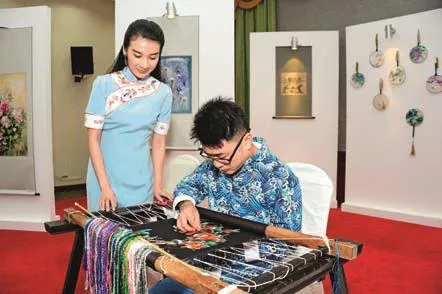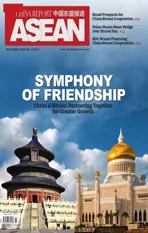STITCHING THE PAST TO THE FUTURE Chinese millennials showing new zest for traditional arts and crafts
2018-11-19ByHouWeili
By Hou Weili

Chinese embroidery has history of more than 2,000 years.
Driving the strong global outreach of Chinese traditional art are dedicated young artists and their pursuits of excellence.
Fu Jian, born in 1987 in eastern Chinese city of Yangzhou, has become a popular name in Chinese embroidery circles in Brunei.His craftsmanship was praised by the Sultan of Brunei when it was showcased at a cultural exchange event in 2015.
Two years later, he solidified his popularity among Bruneians with an embroidered painting featuring Zheng He’s voyages to the Western Seas during the Ming Dynasty (1368-1644).
“I also witnessed the cultural diversity in art produced by Bruneians as well as artists from other Southeast Asian countries,” said Fu.
The young man is representative of Chinese people carrying on the ancient art of embroidery and spreading its embedded friendship, craftsmanship and positivity throughout the world via countries along the Maritime Silk Road.As an intangible cultural heritage, Chinese traditional art of embroidery remains flourishing, and international exchange is dynamic thanks to supportive policies, increased public awareness and closer connectivity brought by the Belt and Road Initiative.
Appeal to Youngsters
Time-honored embroidery with a history of more than 2,000 years was once regarded as a female craft, but it mesmerized Fu Jian just the same. “I consider myself extremely lucky to have the opportunity to pursue a career that happens to be my hobby,”Fu grinned.
Although he was born into a family of embroiderers, Fu encountered strong opposition to his career choice from his parents. “They insisted that stitchwork is a feminine occupation with bleak prospect,” Fu recalled. “It was gender discrimination. But I remained determined to work on the thing that interested me most.”
During his childhood,his parents always seemed preoccupied with threading needles and embroidering various patterns. Their dedication and fastidiousness left a profound influence on Fu,driving his hard work to pursue embroidery excellence.
In 2006, Fu chose to study art design at Beijing University of Technology to further his preparation as a craftsman.While peers were bewildered by the uncertainty they would face after graduation, Fu was already pouring all of his energy into the art as a life-time pursuit.During his spare time, he visited antique stores, furniture markets and art exhibitions—any destination that might inspire his creation.
His dedication paid offat a young age. Fu volunteered to serve the 2008 Beijing Olympic Games and embroidered a work depicting the National Aquatics Center during his spare time.The work was acclaimed by the Beijing Organizing Committee for the Olympic Games, which presented a copy to Juan Antonio Samaranch, then President of the International Olympic Committee. That same year, another work themed around horses was recognized by the United Nations Educational, Scientific and Cultural Organization(UNESCO). More awards flooded in over the following years.
Fu has been sharing his dedication with youth close to his age. According to him,the new generation of artists like himself is lucky compared to their elders. “In college, I was tutored by authoritative engravers and watercolor painters,” he explained. “I also learned traditional Chinese painting, oil painting and sketching. For the master’s program, I studied digital art.”This wide-ranging exposure to various art forms and original ideas drives young artists to cultivate a sound knowledge foundation and aesthetic standards when carrying on traditional art forms.
The Chinese government has introduced various policies to support young people pursuing craftsmanship. Since 2016, national intangible cultural heritage inheritors have been subsidized with 20,000 yuan (US$2,888.7)every year. To respect local cultural traditions and folk craftsmen, governments at various levels help inheritors and businesses solve problems related to manual skills, quality of the handicrafts, brand building, market expansion and employment.
Tradition + Innovation
Fueling the government support is the increasing awareness on effective techniques to preserve and pass on traditional Chinese culture. But subsidies and well wishes for inheritors are far from enough to preserve every intangible treasure. Insiders and experts have stressed that a favorable business environment and consumer recognition and appreciation for cultural products and handicrafts are vital for the sustainable development of intangible cultural heritage.
“Tradition can be revived when inheritors profit from their manual crafts and production and gain dignity by doing what they do best,”remarked Xian Feng, an expert with the Interactive Media Institute of Tsinghua University.“Confidence in their own culture is boosted this way.”
Fu keeps this in mind when empowering local people to seize dignified lives through their crafts. In 2008, he founded a firm and researchcenter focused on embroidery,which has created more than 200 jobs for local women in Baoying County, Yangzhou,and improved their output through lectures and training programs. “Today, this business generates annual revenues of 3 million yuan (US$433,300),” Fu revealed. He devised a platform to achieve win-win results of preserving embroidery while making profits.


To stay abreast of the times and fashion, Fu has been pondering innovations.“Slight changes can result in extraordinary effects,”he realized after years of exploration. “Tradition is the core and content of the art and what identifies it. These should remain eternal. However, we can change how we present the content, such as using digital media. Or we can still mount and frame the artwork in an original way.”
Xian supports innovation but warns against mass production of handicrafts.“Intangible cultural heritage is aesthetic and preserves the unique values of a nation,” he illustrated. “These works are unique because only handmade products can absorb and reflect such values. When commercializing such works,cultural values must be taken into consideration.”
